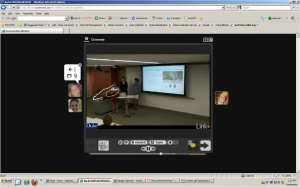Deborah Reisinger, Lecturer, French Program, Romance Studies
Deb Reisinger was one of fourteen faculty and one graduate student who participated in a Spring 2010 CIT Fellowship for language faculty interested in exploring with colleagues the most effective and most efficient ways to increase students’ oral production in the target language, in order to increase students’ language learning.
Reisinger’s project explored having students play a greater role in the assessment process, and asked whether this increased role resulted in improved (or a perceived improvement in) oral presentation skills. The project goals were:
- to bring student self-awareness to specific aspects of oral performance and presentation,
- to improve oral presentation skills, and
- to increase student engagement in unmonitored class assignments such as pair work.
Students were video recorded giving presentations three times during the semester, and used a class-created self-assessment rubric to gauge their skills. The videos were either posted in Blackboard or in VoiceThread for student viewing (videos private to each student). The videotaping was used to give students the opportunity to watch (and rewatch) their presentations; this also allowed Reisinger to re-watch, creating a new environment for her assessment of the student presentations that often elicited different feedback. Posting in VoiceThread allowed students to record oral commentary (doodling, webcam and audio) on voice-over of presentations, in addition to completing the rubric.
In addition, students completed surveys before the initial assignment and at the end of the class to judge their current practices (how do they prepare for and process their goals) and perceptions (how do they perceive their skills). Survey results showed that students perceived an improvement in their presentation skills over the course of the semester. Students attributed this to giving multiple presentations (83%), watching peer and personal presentations (58%), incorporating feedback (48%), but not to completing written assessments (<1%).
Reisinger’s best practices or lessons learned:
- Add more open ended questions to the survey and stick to about 10 questions (I used fewer to not overwhelm, but not wish I had more data).
- Use VoiceThread over the whole semester. Although this was my intended use, it did not work out for various technological reasons. QuickTime Pro is a quick and easy editor to use to upload video to VoiceThread.
- Maintain the class-devised rubric activity, which was essential to raising student awareness of best practices, but have them use it as a guideline for self-assessment recordings, rather than a written assignment.
- Create a model of self-assessment based on my own teaching — this will serve multiple goals: a model of how to give a presentation (where to stand, how to move throughout the class), a model of what not to do (I can voice over critique of “bad practices”), and also create good learner community.

